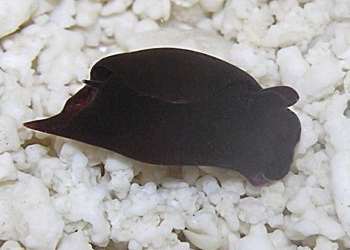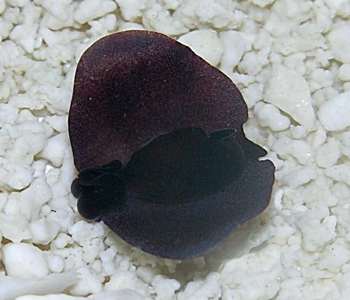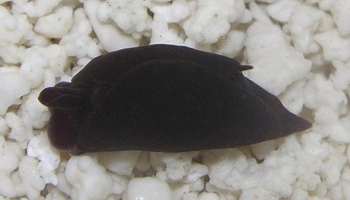Unknown Gastropteron from the Bahamas
August 30, 2005
From: Anne DuPont


Hello Bill,
This past winter in the Bahamas I found these (?) Gastropteron chacmol (?). The first day that I found them there were hundreds on the sand. They were black and appear to be different in several ways from other G. chacmol that I have found. These were much larger, were solid black in color, had no yellow border and the tail appears to be shorter. They swam actively when disturbed. Is this a color variation of G. chacmol?
Location: Sand Dollar Beach, Stocking Island, Exumas, Bahamas, 3-6 feet of water. January 9, 2005. Size: Approximately 9 mm.
Cordially,
Anne DuPont
Delray Beach, FL
akdupont@bellsouth.net
DuPont, A., 2005 (Aug 30) Unknown Gastropteron from the Bahamas. [Message in] Sea Slug Forum. Australian Museum, Sydney. Available from http://www.seaslugforum.net/find/14648
Dear Anne,
At present only three species of Gastropteron have been described from the Caribbean - G. chacmol, G. hamanni and G. vespertilium [see message #11964]. I am pretty sure it is not G. chacmol both on colour grounds and on the length of the mantle flagellum (or tail). Also, from my experience a good pair of experienced amateur eyes are often right and you have seen large numbers of both typical G. chacmol and this black animal. Gastropteron hamanni was described from a single specimen, but it was a uniform yellow.
My guess is that this is a form of G. vespertilium but we need to know about its anatomy to be sure. Unfortunately this species was described from only a few specimens but the animals were said to be abundant. The animals were described as being a grayish or purplish black with occasional blue grey spots on parapodia and a thin bright yellow line at the edge of the parapodia and the siphon, although in some specimens the margin is 'greenish or pale blue'. The flagellum on the visceral hump is charcoal gray basally and white in the upper half. Unfortunately there is no indication how many animals were examined alive so we do not know if the yellow border is usually present or perhaps usually absent. If the latter, then your animals could well be G. vespertilium. The position of the flagellum, attached halfway along the side of the visceral hump is certainly similar, but again we have no indication just how typical the white pigmentation on the upper half of the flagellum is.
I guess that as well as getting some specimens, if you see it again, it might be useful to check a and see if there are specimens with a coloured border to the parapodia and a white tip to the flagellum. Not the easiest request to address in such a small animal while diving. Rather than making a Fact Sheet for another unidentified Gastropteron I will place this with G. vespertilium on a temporary basis.
Best wishes,
Bill Rudman
